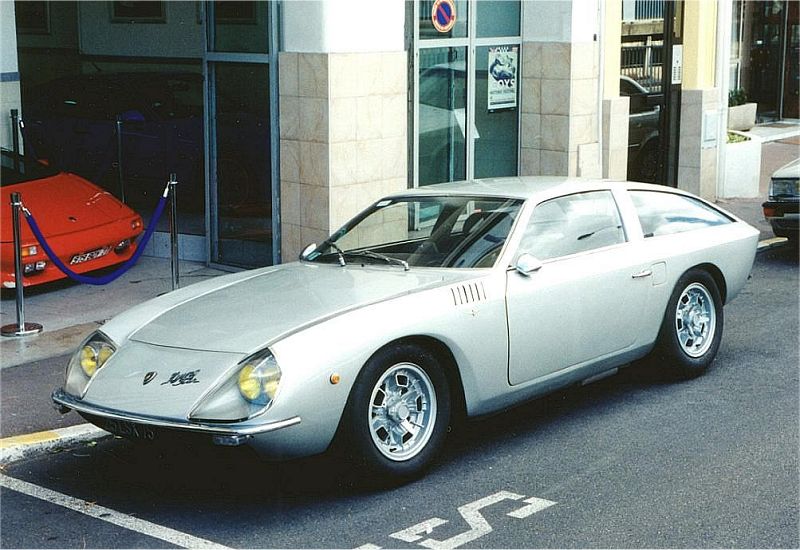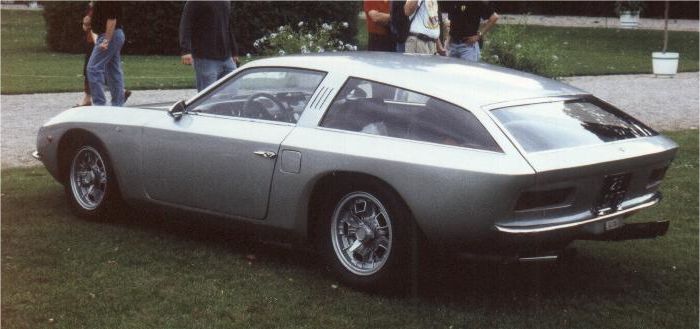Description
The Lamborghini 400 GT Flying Star II Touring was a striking one-off prototype that demonstrated the creative brilliance of 1960s Italian coachbuilding. Built in 1966 by Carrozzeria Touring of Milan, it was a bold, futuristic reinterpretation of the Lamborghini 400 GT chassis—a shooting brake–style coupé that combined grand touring performance with avant-garde design. As one of the most daring and memorable coachbuilt Lamborghinis ever created, the Flying Star II captured a fleeting moment in automotive history when craftsmanship, innovation, and imagination converged to produce something truly unique.
The car was unveiled at the 1966 Turin Motor Show, at a time when Lamborghini was still a young company gaining momentum after the success of the 350 GT and 400 GT 2+2. Touring, who had bodied those earlier models, wanted to demonstrate its continued relevance in a rapidly changing industry dominated by new materials and design philosophies. The Flying Star II was conceived as a modern showpiece—a car that would not only showcase Touring’s technical skill but also reinterpret Lamborghini’s engineering into a completely different form.
The name “Flying Star” had historical resonance for Touring. It had been used on several earlier custom-bodied Alfa Romeos and Lancias during the 1930s, all of which shared a theme of elegance, motion, and modernity. The Lamborghini Flying Star II revived that spirit for a new era, translating it into the bold, angular idiom of mid-century automotive design.
Underneath its dramatic bodywork, the Flying Star II used the same mechanical layout as the production Lamborghini 400 GT. Power came from the 3,929 cc all-aluminium V12 engine, originally designed by Giotto Bizzarrini and refined for production by Gian Paolo Dallara. With four overhead camshafts and six twin-choke Weber carburetors, the engine delivered 320 horsepower and a top speed approaching 250 km/h (155 mph). Power was transmitted through Lamborghini’s five-speed manual gearbox to the rear wheels, while the fully independent suspension—double wishbones with coil springs and telescopic dampers—ensured a ride that was supple yet precise. Girling disc brakes on all four wheels provided confident stopping power, maintaining the car’s reputation for balance and control.
Where the Flying Star II truly stood apart was in its design. Touring’s bodywork was unlike anything Lamborghini—or any other manufacturer—had attempted before. The car was a sleek shooting brake with a sharply defined wedge profile, long bonnet, and a roofline that extended gracefully into an abruptly truncated tail. The proportions were audacious: low, wide, and angular, yet perfectly balanced. The front featured a minimalist grille flanked by pop-up headlights and clean horizontal lines that emphasized width and modernity. The windscreen was steeply raked, the sides nearly flat, and the rear end squared off in a design that prefigured the geometric aesthetic that would later define the 1970s.
Touring’s execution was as meticulous as it was imaginative. The body was built using its patented Superleggera technique—aluminium panels stretched over a lattice of lightweight steel tubes—which gave the car both rigidity and lightness. The craftsmanship was exquisite: tight panel gaps, hand-finished contours, and delicate chrome details that traced the car’s crisp edges. The interior, finished in fine tan leather, was both luxurious and modern, with an emphasis on simplicity and form. A sweeping dashboard housed a full suite of Jaeger instruments, while the low, wraparound windscreen created an airy, panoramic cabin atmosphere.
Driving impressions of the Flying Star II suggested that it performed as well as it looked. The V12 engine provided smooth, effortless power delivery, and the car retained the supple ride and sure-footed handling of the standard 400 GT. Though it was heavier than the production coupé due to its unique body structure, it remained quick and composed, capable of covering long distances at high speed with ease. The cabin’s spaciousness and the practicality of its shooting brake layout hinted at a grand touring car that could be both exotic and usable—a concept decades ahead of its time.
Despite its brilliance, the Flying Star II remained a one-off. Carrozzeria Touring was in financial trouble during the mid-1960s, struggling to adapt to the shift from hand-built aluminium construction to mass-produced steel bodywork. The company went bankrupt shortly after the Flying Star II was completed, making this car not only the last Touring-bodied Lamborghini but also one of the final creations from one of Italy’s most storied coachbuilders. The car was displayed only briefly before being sold into private hands, where it remained for many years, occasionally resurfacing at concours events and exhibitions.
In retrospect, the Flying Star II stands as both a masterpiece and an elegy. It represented the end of the traditional coachbuilding era in Italy—a time when designers and craftsmen could still build extraordinary one-off automobiles by hand, each infused with the character and vision of its maker. Yet it also foreshadowed the future of Lamborghini design, anticipating the bold, geometric forms that would later emerge in cars like the Espada and the Countach.
Today, the Lamborghini 400 GT Flying Star II Touring is regarded as one of the most fascinating and collectible prototypes in Lamborghini’s history. Its combination of artistry, engineering, and historical significance makes it a landmark in the evolution of the Italian grand tourer. More than just a car, it was an idea—an exploration of what a Lamborghini could be when freed from convention.
The Flying Star II remains a monument to a moment of boundless creativity, when Touring and Lamborghini together created something entirely original: a grand touring sculpture in motion, equal parts elegance, power, and imagination.

